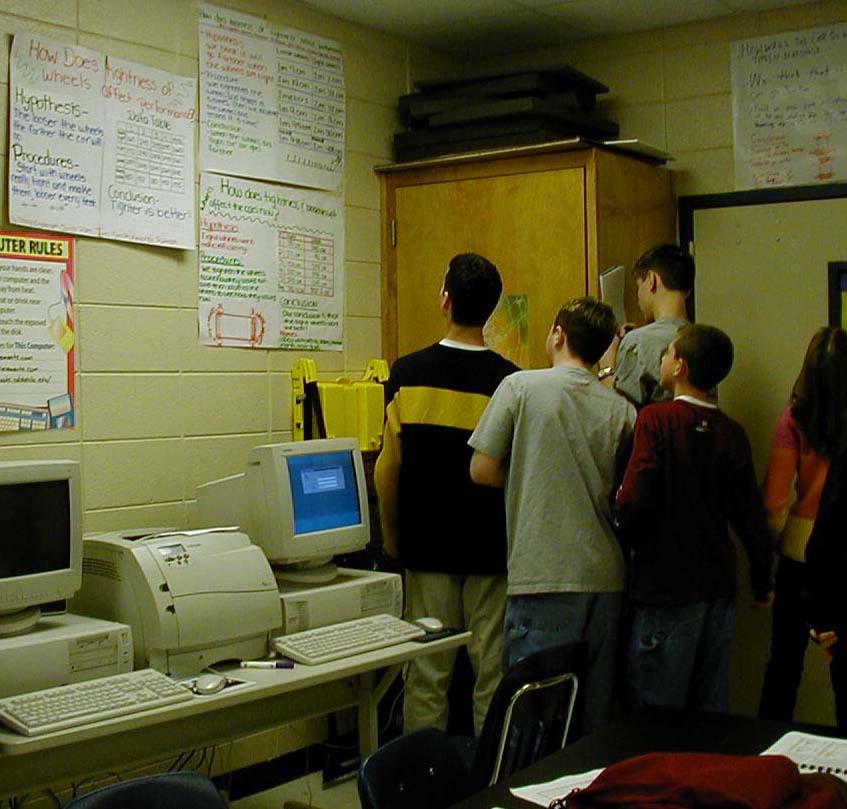 During their second or third gallery walk, students invariably begin to accuse each other of copying. They've seen each other's ideas and identified some as better than their own or seen ways to integrate someone else's idea with one they already had. The accusations of copying provide the teacher with the opportunity to formally introduce students to the notions of collaboration and citation. Students learn that borrowing is essential for scientists and engineers as they move their fields forward. They are told that scientists and engineers use patents and reports to identify what they have learned or discovered, and other scientists and engineers cite those patents and reports as they find them useful to use. Students are encouraged to borrow ideas from each other and adapt them to fit their needs, so long as they cite the groups they are borrowing from.
During their second or third gallery walk, students invariably begin to accuse each other of copying. They've seen each other's ideas and identified some as better than their own or seen ways to integrate someone else's idea with one they already had. The accusations of copying provide the teacher with the opportunity to formally introduce students to the notions of collaboration and citation. Students learn that borrowing is essential for scientists and engineers as they move their fields forward. They are told that scientists and engineers use patents and reports to identify what they have learned or discovered, and other scientists and engineers cite those patents and reports as they find them useful to use. Students are encouraged to borrow ideas from each other and adapt them to fit their needs, so long as they cite the groups they are borrowing from.
As well, during this activity, the class engages in the activities and language of iterative design. They learn that the limitations of the materials they are using are what engineers call constraints and that the goals they are trying to achieve are what engineers and other designers call criteria. They learn that the revision cycle they are using is called iteration, and that one can almost never design a complex artifact correctly the first time - that iteration is the natural way among designers. They experience, as well, that when something doesn't work as well as they want, it's worth asking a question about why and finding out answers, and that designers do that too.
Next, we ask students to participate in a science investigation - one that requires control of the environment and procedure for replicability - the Oreo Cookie Challenge (1). We ask students to determine how many drops of icing will fit on a new kind of sandwich cookie. They encounter the importance of anticipating what variables need to be controlled, running pilot experiments, controlling variables, doing procedures consistently, and what it takes to be able to trust some other scientist's results. The class, as a whole, has to be able to make a recommendation to the cookie company about how many drops of icing their machines should be set to drop on each cookie half. Student groups each drop water on pennies to simulate dropping icing on cookies. When students first report their results to the class, they see that results are all over the place - some groups might have dropped 15 to 20 drops on their pennies, while other groups might have dropped up to 80 or even 100. They are curious as to why. They examine each others' procedures, noticing that some hold the dropper higher than others, some drop water until it looks like the cookie will overflow on the next drop while others drop until water overflows and subtract one, some drop full drops while others drop small drops, some drop their water in the center, others on the side, and so on. They decide which are the most important variables and standardize those, and each group drops water on its pennies again using the new standardized procedure, reporting the results to the class. The second time, of course, results across groups are more consistent, but they still aren't consistent enough to make a recommendation. Students ask each other questions to discover other differences, standardize the procedure better, and try again, bringing more consistency. This activity seems to be an excellent one for helping students recognize the importance of controlling variables, the importance of doing procedures the same way every time, and the role of replicability in science investigation.
|

